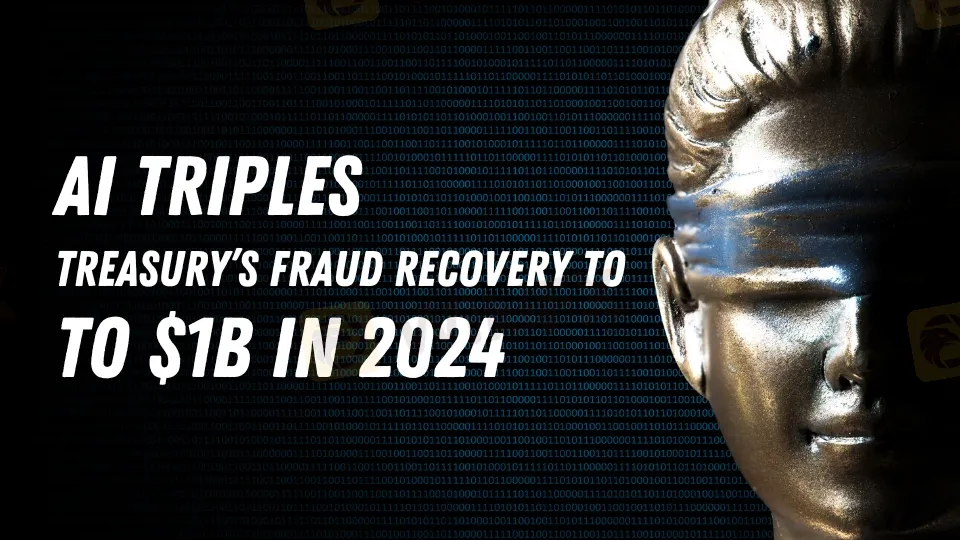简体中文
繁體中文
English
Pусский
日本語
ภาษาไทย
Tiếng Việt
Bahasa Indonesia
Español
हिन्दी
Filippiiniläinen
Français
Deutsch
Português
Türkçe
한국어
العربية
AI Triples U.S. Treasury’s Fraud Recovery to $1B in 2024
Abstract:The U.S. Treasury's use of AI for fraud detection leads to a significant increase in recovery, reaching $1 billion in fiscal 2024, thanks to machine learning.

The U.S. Treasury Department has achieved significant success in combating financial crime by adopting artificial intelligence (AI), recovering an impressive $1 billion in check fraud during fiscal year 2024. This marks a nearly threefold increase compared to the previous year and underscores the transformative role AI plays in fraud detection.
Treasury officials attribute much of this success to machine learning, which enabled the department to detect and prevent over $4 billion in fraud—a sixfold increase from the prior fiscal year. Renata Miskell, a senior Treasury official, emphasized that AI's ability to identify hidden patterns and anomalies in vast datasets has substantially improved the department's fraud detection capabilities.
The Treasury‘s journey into AI began in late 2022, aligning its efforts with the established practices of banks and credit card companies. Unlike generative AI models, which focus on generating text and images, the Treasury's system employs machine learning to analyze data and identify suspicious activity at speeds far beyond human capability. This speed is crucial, given the Treasury’s responsibility for managing an annual payment volume of around $7 trillion, including Social Security payments, tax refunds, and federal payroll.
The rise in fraud, particularly following the COVID-19 pandemic, has highlighted the importance of AI in protecting taxpayer dollars from scams. Despite these advancements, concerns about AIs potential misuse by bad actors have surfaced. Treasury Secretary Janet Yellen and other officials have warned about the risks AI could pose to the financial system.
In response, Miskell assured that human oversight remains a critical part of the process. Every flagged transaction undergoes a thorough review by a human before any determination of fraud is made, ensuring that AI enhances, rather than replaces, human judgment.
As the Treasury expands its AI initiatives, it is working with state agencies to improve fraud detection tools, especially in areas like unemployment insurance fraud. The IRS has also announced plans to use AI to identify tax evasion schemes, reflecting a broader trend among federal agencies to adopt technology for financial oversight.
Final Thoughts
The U.S. Treasurys successful integration of AI in fraud detection demonstrates the power of technology to strengthen financial security while highlighting the need for balanced human oversight. As fraud schemes grow more sophisticated, the continuous evolution of AI tools and practices will be essential to protecting taxpayer funds and maintaining trust in the financial system.

Disclaimer:
The views in this article only represent the author's personal views, and do not constitute investment advice on this platform. This platform does not guarantee the accuracy, completeness and timeliness of the information in the article, and will not be liable for any loss caused by the use of or reliance on the information in the article.
Read more

Justice Served: Illegal Investment Scheme Ends in RM28 Million Repayment
The Kuala Lumpur High Court has ruled that a Singaporean businessman, Chan Cheh Shin, must return RM28 million to 122 Malaysian investors after the court determined that his investment operations were conducted illegally.

RM900,000 Scammed: The Hidden Dangers of Online Investment Schemes
A 53-year-old factory manager from Malaysia has fallen victim to an online investment scam, losing over RM900,000 of her savings. This case underscores the growing threat of online scams preying on unsuspecting individuals.

Tokyo Police Arrest 4 for Unregistered FX Trading Scheme
Four men in Tokyo were arrested for running an unregistered FX trading operation, collecting over ¥1.6 billion from 1,500 investors.

Doo Group Expands Its Operations with CySEC License
Doo Financial, part of Doo Group, receives a CySEC license, allowing FX/CFD services in Europe. This strengthens its global presence and regulatory standards.
WikiFX Broker
Latest News
Why Even the Highly Educated Fall Victim to Investment Scams?
Warning Against Globalmarketsbull & Cryptclubmarket
BSP Shuts Down Uno Forex Over Serious AML Violations
ACY Securities Expands Global Footprint with South Africa Acquisition
Tokyo Police Arrest 4 for Unregistered FX Trading Scheme
Rupee gains against Euro
Axi Bids AUD 52M to Acquire Low-Cost Broker SelfWealth, Outbidding Competitor Bell Financial
Crypto Influencer's Body Found Months After Kidnapping
US Regulators Tighten Oversight on Bank Anti-Money Laundering Efforts
Doo Group Expands Its Operations with CySEC License
Currency Calculator


